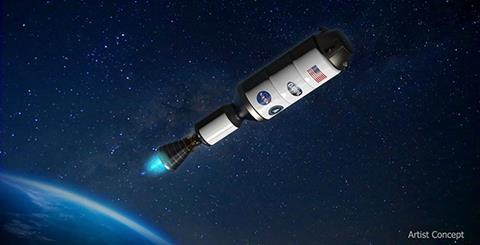Defense aerospace manufacturer Lockheed Martin will build a reusable nuclear-powered spacecraft in partnership with NASA and the Pentagon.
Lockheed said on 26 July it has secured a contract from the secretive Defense Advanced Research Projects Agency (DARPA) that will fund fabrication of a nuclear thermal rocket that will achieve space flight by 2027.

“These more-powerful and -efficient nuclear thermal propulsion systems can provide faster transit times between destinations,” says Kirk Shireman, vice-president of lunar exploration campaigns at Lockheed Martin Space. “This is a prime technology that can be used to transport humans and materials to the moon.”
Known as Demonstration Rocket for Agile Cislunar Operations (DRACO), the project aims to deliver vehicles with the same thrust as conventional rockets, but with two-to-three times greater efficiency. The term “cislunar” refers to the zone of space between Earth and the moon.
Fuel is one of the greatest limiting factors for crewed and uncrewed space travel. The ability of the more-efficient nuclear thermal rocket to produce thrust for longer periods creates the potential to reduce transit times between Earth and other celestial bodies, or give spacecraft more ability to manoeuvre around Earth.
“Reducing transit time is vital for human missions to Mars, to limit a crew’s exposure to radiation,” notes Shireman. NASA’s Artemis programme aims to return astronauts to the moon as soon as 2026. The effort is seen as a precursor to subsequent crewed missions to Mars.
While DRACO is not currently part of those plans, if the space flight demonstration goes well, it could precede use of the technology in future space missions or commercial operations.
“The DRACO programme aims to give the nation leap-ahead propulsion capability,” says Tabitha Dodson, DARPA’s programme manager for the effort. “With a successful demonstration, we could significantly advance humanity’s means for going faster and farther in space and pave the way for the future deployment for all fission-based nuclear space technologies.”
The concept engine uses a nuclear reactor to quickly heat hydrogen propellant to extremely hot temperatures, before funnelling the gas through the engine nozzle to create powerful thrust, Lockheed says.
The fission-based reactor planned for DRACO will use high-assay, low-enriched uranium, or HALEU, to convert ultra-cold cryogenic hydrogen into extremely hot pressurised gas.
Lockheed notes the nuclear reactor will not be turned on until the spacecraft has reached a “nuclear safe orbit”. The company describes the nuclear thermal propulsion system as “very safe”.
Lockheed has partnered with BWX Technologies, a Virginia supplier of nuclear components and fuel, to develop the DRACO nuclear reactor and produce the HALEU fuel.
In addition to the DRACO engine, Lockheed plans to develop an accompanying space vehicle known as the experimental nuclear thermal reactor vehicle (X-NRTV).
The US Space Force intends to transport the X-NRTV into space in 2027 for the DRACO demonstration, DARPA says.
Although Washington is officially against the militarisation of space, such a platform also has potential defence applications.
”With more speed, agility and manoeuvrability, nuclear-thermal propulsion also has many national security applications for cislunar space,” Shireman notes.
Limitations from fuel and manoeuvrability currently restrict most military space operations to satellites in low Earth orbit.


























